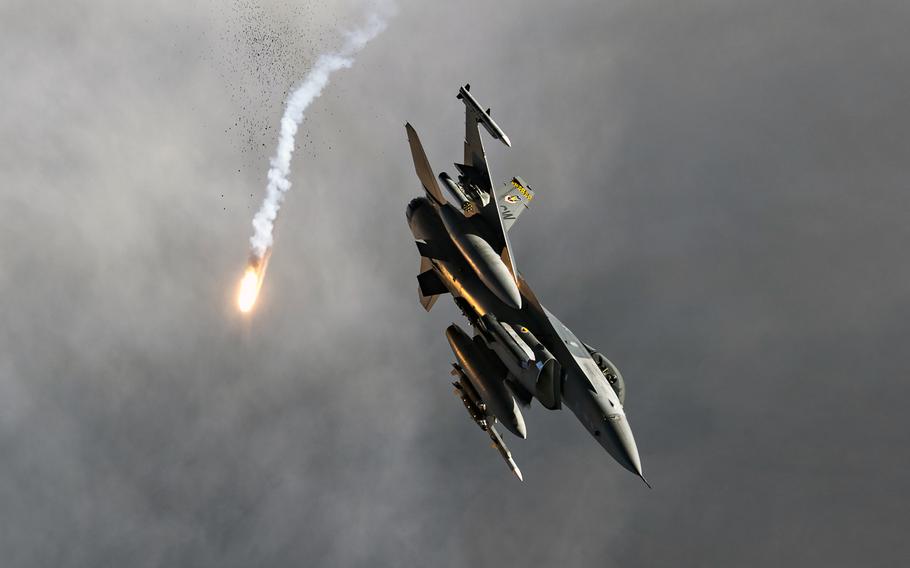
An Air Force F-16 Fighting Falcon from the 79th Fighter Squadron at Shaw Air Force Base, S.C., releases flares over Afghanistan, Nov. 12, 2019. The U.S. dropped more bombs and other munitions in Afghanistan last year than any other year since documentation began in 2006, Air Force data shows. (Matthew Lotz/U.S. Air Force)
KABUL, Afghanistan — The United States dropped more bombs and other munitions in Afghanistan last year than any other year since documentation began in 2006, Air Force data shows.
American aircraft released 7,423 munitions in the country in 2019, according to figures published Monday by U.S. Air Forces Central Command. Coalition aircraft flew nearly 8,800 sorties during the period, over a quarter of which carried out strikes.
The tally surpasses the previous record set last year when 7,362 munitions were released and comes amid ongoing discussion between American and Taliban officials aimed at ending America’s longest war.
Talks between the two sides continued for most of 2019 as American bombs were dropped.
“The U.S. has been very explicitly using stepped-up attacks on the Taliban as a form of leverage-seeking,” Laurel Miller, former U.S. acting Special Representative for Afghanistan and Pakistan, said in a phone interview, adding that the Taliban also sees violence as its main form of leverage.
The U.S.-Taliban talks resumed last month in Qatar after a three-month pause.
The AFCENT figures include bomb and missile strikes, 105 mm shells fired by AC-130 gunships and strafing fire from 20 mm cannons and up.
Airstrikes, predominantly conducted by U.S. forces, caused 579 of the 1,149 civilian war fatalities attributed to pro-government forces in Afghanistan during the first nine months of 2019, according to the most recent United Nations data. Insurgent groups were responsible for 1,207 civilian deaths in that time, the U.N. data showed. Another 207 civilian deaths were unattributed to either side.
Last week, Afghanistan’s Independent Human Rights Commission blamed a U.S. drone strike conducted earlier this month in western Herat province for killing 15 civilians, including three children.
“The commission has repeatedly called on domestic and foreign forces to be more careful in conducting military operations so that civilians are not harmed,” the commission said.
A spokesman for U.S. and NATO forces in Afghanistan confirmed the U.S. military carried out the strike in support of government forces. Afghan authorities said an investigation was ongoing.
While U.S.-trained Afghan forces are capable of conducting ground operations, they still need air support to fight insurgents and terrorist groups, like the local Islamic State affiliate, said Rohullah Ahmadzai, Afghan Defense Ministry spokesman.
“The cooperation of foreign forces is vital for us,” Ahmadzai said.
The defense ministry was unable to say how many munitions Afghan forces released in 2019.
Zubair Babakarkhail contributed to this report
wellman.philllip@stripes.com Twitter: @pwwellman